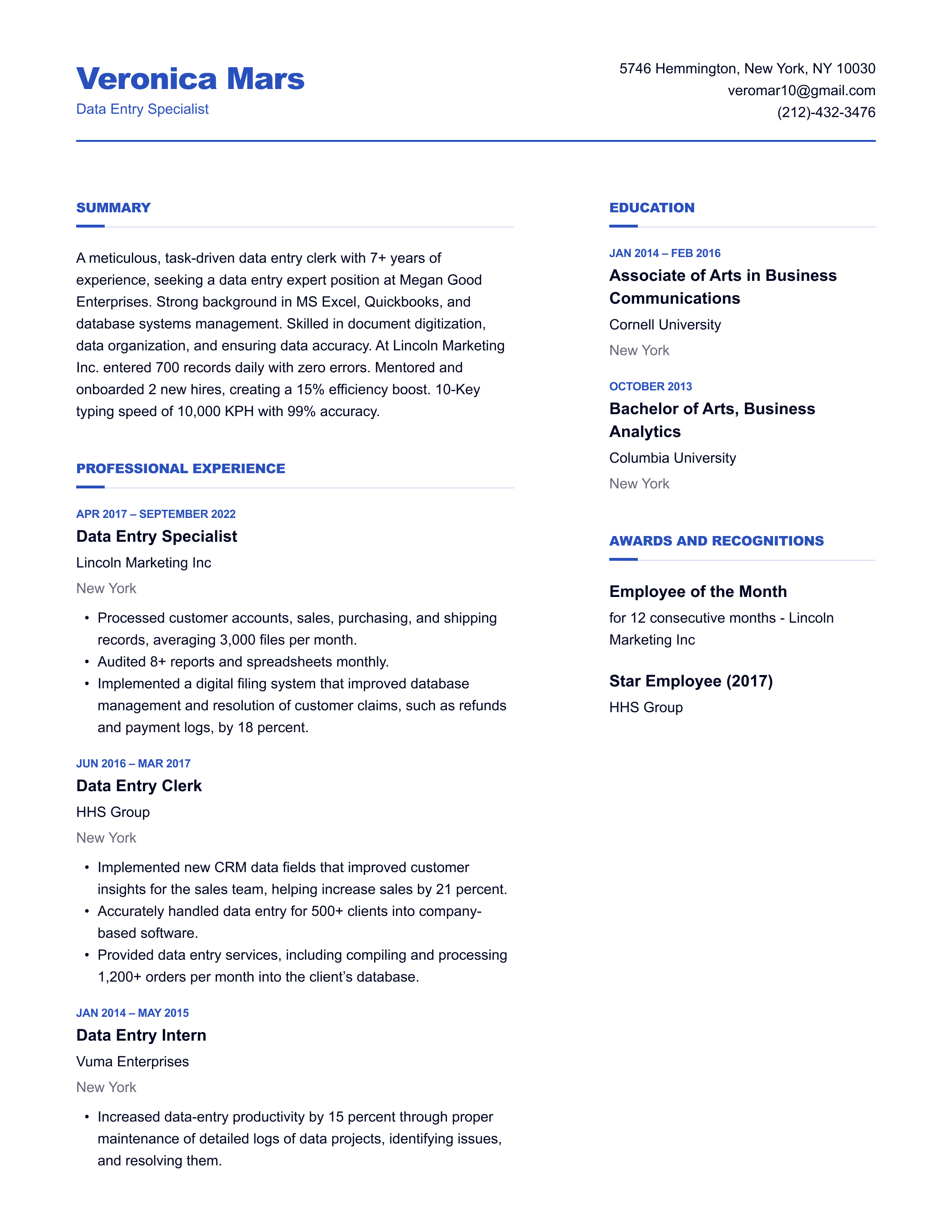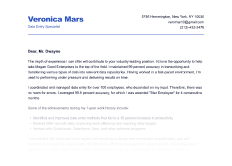You have a strong knowledge of MS Excel and QuickBooks and can average a typing speed of 70 WPM. You are
proficient in transcription and are a numbers whizz.
But, how do you convince the hiring team that you have what it takes? You need a data entry resume that
demonstrates your expertise and skills. Remember,
recruiters spend just 7.4 seconds scanning your resume . So, you must make it as convincing,
impressive, and attention-grabbing as possible.
In this data entry resume guide, we answer the questions:
- How do I describe my data entry on a resume?
- How can I write myself for a data entry job?
- What’s the best resume format for a data entry specialist?
- What are the common elements of a resume?
- What are data entry skills?
We’ll also share an adaptable data entry resume template and useful tips for writing a successful data entry
resume.
Facts About Data Entry Job Market
Before we get into the details, here are some facts about data entry jobs:
We live in a data-driven world, meaning the data industry is in constant growth. No wonder many companies have
vacancies for data entry clerks. This means with the right data entry skill set and a well-crafted data entry
resume, you’ll be in high demand.
So, how much does a data entry clerk earn? According to
PayScale
, the average hourly pay for a data entry specialist is $14.62. Of course, the rates differ by industry,
experience level, and roles in the company.
Another
survey by Glassdoor
suggests that the average salary for a data entry specialist is $38,842 per year, with the likelihood of making
more depending on your skills, education, and career level.
Data Entry Job Description
Data entry is the process of entering or updating
information and records into a database or computer system. Data entry professionals use computers and data
processing programs to input data.
Data entry specialists may also transcribe data from recordings or phone conversations. As a data entry
specialist, attention to detail is paramount, as mistakes can lead to significant problems for the company.
Some of the key roles and responsibilities of a data entry clerk include:
- Creating spreadsheets with vast numbers of figures without errors
- Transferring data from paper format to computer files or database systems
- Maintaining databases by entering new and updated customer details
- Purging files to eliminate duplication of data
- Scanning and printing required documents
- Generating weekly and monthly reports for a company
- Reviewing all data for errors and reporting unusual findings to management
To qualify as a data entry specialist, you will need at least a high school diploma, one year of experience in a
relevant field, and a good command of English. In addition, you must be knowledgeable in MS Word and Excel, and
have strong interpersonal and communication skills.
It goes without saying that you must be proficient in typing, with a speed of at least 40 WPM. You’ll also need
to have experience working with data entry software and office computer systems.
How to Write a Data Entry Resume
Want to write a job-winning data entry resume? We share a data entry resume example and explore the
various parts that you need to include in your resume to stand out.
Choose the Correct Format for your Data Entry Resume
You should know that
99 percent
of Fortune 500 companies use an Applicant Tracking System to filter resumes. Therefore, not only should you use
the best resume format, but it's also important to match each resume for the specific job.
What Exactly Is an ATS?
An applicant tracking system makes the work of hiring managers simpler. The ATS sorts resumes and ranks them, as
per the set keywords and other parameters. This saves recruiters from having to manually review each resume.
Applicant tracking systems automatically scan resumes, ranking candidates by comparing the uploaded data on the
resume to the job description. This means that only an optimally formatted resume will pass the scan.
To learn more about how an applicant tracking system works, read our article:
When formatting your resume, you need to use the right layout. Here are our recommendations:
- Use
one-inch margins
on all sides.
- Use a font that stands out, but not too much
. Good fonts include Calibri, Roboto, Tahoma, and Verdana. Avoid fonts like Comics Sans and others that are
meant for illustrations.
- Make sure your resume fits on one page
. While a two-page resume is acceptable, around
17
percent
of hiring managers consider it too long and may not read it.
- Use headings
, such as H2, to make your resume clearer.
- Use bold fonts, italics, and underlining
(albeit sparingly), to break up text and make the document easier to read.
- Maintain single or 1.15-line spacing
- Stick to the standard font size (11-12pt) for normal text and 14-16pt for headers.
When it comes to the
best resume format
,
reverse chronological
should be your first choice. In this format, your latest work experience is listed first, and is ideal for
people with plenty of work history that is relevant to the position they are applying for.
You can also opt for other resume formats, which are:
- Functional resume
. It focuses on skills rather than professional experience. It’s a great choice for people without a lot of
work experience but who possess relevant skills for the position they are interested in. It's also a good
choice if you have gaps in your employment history.
- Combination resume
. This format combines the “Functional” and “Reverse-Chronological” resume formats. It emphasizes skills and
work experience. This format is suitable if you have plenty of relevant work experience or if you want to
change industries.
Data entry job descriptions are often very specific about the roles, responsibilities, and skills they are
looking for. Do your best to match the professional summary, experience, and skills section to reflect those
duties. For example, as a data entry clerk, your performance is judged by speed and accuracy. Therefore, use
statistics to showcase what you're capable of.
Data Entry Resume Example
Resume Sections
With the
resume format and layout out of the way, let's get down into the nitty gritty of data entry resume writing.
Here are some of the sections to include on a data entry resume:
- Name and contact information
- Professional summary
- Professional experience
- Education
- Skills
You can also add these sections to make your resume stand out more:
- Memberships
- Certifications,
- Languages
- Publications
- Hobbies and interests
- Internships
- Awards and recognitions
Now, let us go through each section in more detail:
This is the header section of your resume,
which carries your name and contact information. To most people, this section might seem like a no-brainer.
However, you’ll be shocked at the number of silly mistakes people make, like forgetting the country code or
using an unprofessional email address.
For your contact, you should include:
- Your full name.
- Your title – in our example, Data Entry Specialist.
- Phone number, including the area code.
- Email address. Please, use a professional email address. Not the one you created in 8th grade.
- Location (optional). This might be necessary if you're applying for a job abroad.
Veronica Mars
Data Entry Whizz
(212)-432-3476
Geeky__chick@hotmail.com
Veronica Mars
Data Entry Specialist
(212)-432-3476
Veromar_10@gmail.com
5746 Hemmington, New York, NY 10030
Double-check or even triple-check your contact information details. A small typo can deny you the chance of a
potential employer contacting you. In addition, make your name the largest element to make it stand out. Use
bold and 20pt font size.
Also, consider adding the following in your header section:
- An online portfolio or website (if it's relevant to your work).
- Your social media profile (if it's relevant to the position).
LinkedIn
is a great option.
Professional summary section
Data entry jobs are flooded with experts having
years of experience. This makes it hard to shine among the hundreds of job applicants. What’s more, recruiters
spend only a few seconds on a resume.
This means if you don’t grab the HR manager's attention within the first five seconds, then your resume goes into
the “Discard” bin!
Luckily, there’s a way to hook the hiring manager right off the bat. The summary section of your resume gives you
the chance to impress the hiring team. The summary is a 2-3 sentence long paragraph that lets you briefly
demonstrate your work experience, achievements, and accomplishments.
It displays your top skills for data entry and tells the hiring manager what they can expect to gain by hiring
you.
Check out our example:
Summary
A meticulous, task-driven data entry Clerk with 7+ years of experience, seeking a data
entry expert position at Megan Good Enterprises. Strong background in MS Excel,
Quickbooks, and database systems management. Skilled in document digitization, data
organization, and ensuring data accuracy. At Lincoln Marketing Inc. entered 700 records
daily with 99% accuracy. Mentored and onboarded 2 new hires, creating a 15%
efficiency boost. 10-Key typing speed of 12,000 KPH with zero errors
Recruiters will find this impressive because:
- it uses real data to support your points about your experience
- it mentions a few software programs the applicant is proficient in and that are relevant to data entry
jobs
- it’s personalized to the (hypothetical) job description, focusing on what the employer is looking for
(skilled in document digitization, data organization, and data accuracy)
- Mentions typing speed
Professional experience section
The work history or professional experience
section is the most important on a resume. It shows the recruiters that you have worked in a professional
environment and the skills you applied on the job.
To ensure your resume is organized and neat, use the following structure:
- Your Position
- Company name
- Years and months worked there
- 3-5 bullet points listing your roles and achievements
The data entry resume example we prepared shows you what the work experience section should look like:
Professional Experience
Data Entry Specialist
Lincoln Marketing Inc. New York
Apr 2017 - September 2022
- Scanned documents and saved in database to keep records of essential organizational information.
- Entered numerical data into databases with speed and accuracy using a 10-key pad.
- Audited 8+ reports and spreadsheets monthly.
- Accurately reviewed and processed electronic files via software applications such
as Microsoft Excel and Adobe Acrobat.
Data Entry Specialist
HHS Group, New York
Jun 2016 - Mar 2017
- Offered friendly and efficient service to customers, and handled challenging
situations with ease.
- Managed and coded hundreds of incoming electronic documents.
- Collaborated with staff to review weekly data files for outgoing communications.
- Adjusted and processed donations, records, and files as needed
Data Entry Intern
Vuma Enterprises, New York
Jan 2014 - May 2015
- Increased data-entry productivity by maintaining detailed logs of data projects,
identifying issues, and improving them.
- Completed paperwork, recognizing discrepancies and promptly addressing them
for resolution.
- Prepared and organized documents for data entry.
In our data entry resume template, we talk about:
- The number of reports the candidate audited per month.
- Proficiency in MS Excel and Adobe Acrobat
- How much the candidate boosted efficiency
What if I don’t have work experience? If you're a student or recent graduate, you can list relevant courses
you’ve taken, school projects, or internships. In addition, consider highlighting elements of your studies that
demonstrate your passion for data, your savviness with data management systems, and your attention to
detail.
Tips to consider when writing your work experience:
- Use action words, such as tailored, analyzed, adapted, improved, collaborated, etc., at the beginning of
your statements. These words make your resume shine!
- Only display relevant work experience
- Use quantifiable metrics to illustrate your achievements
Tailor your resume to the specific job you're applying for. The applicant tracking system checks for keywords
and compares your resume to the job ad. Submitting a generic resume may lead to automatic rejection.
Education section
Education
Associate of Arts in Business Communications, Cornell University, New York — Jan 2014- Feb 2016
Bachelor of Arts, Business Analytics, Columbia University, New York — October 2013
You may be wondering if you need to include the education section
on your data entry resume? The short answer is yes! Most data entry positions require a high school diploma or
higher.
This section is straightforward – simply list your educational experience in reverse chronological order. Here’s
how to structure your cover letter education section:
- Name of school and location
- Degree type
- Year graduated
Tips to guide you when writing your education on a resume:
- If you haven’t completed your college or university, indicate “Present” as the end date. If you dropped out,
you can write the years studied.
- List your high school education only if you don’t have a higher education.
- Mention your GPA if its higher than 3.5
If you have taken typing classes or other relevant courses, include them. You want to show the recruiter that
you have learned the skills necessary for the job.
Skills section
When adding skills to your resume, we recommend going back to the
job ad to check for the skills the hiring manager is looking for. This way, you can include skills relevant to
the position and increase your chances of getting invited for an interview.
To ensure the recruiter sees your skills, consider adding a dedicated “Skills” section on your resume. Some of
the common data entry skills to put on your resume include:
Soft Skills:
- Accuracy
- Confidentiality
- Self-motivation
- Time management
- Attention to detail
- Communication
- Customer service
- Organizational
- Teamwork
- Multitasking
- People skills
Hard Skills:
- 10-key experience
- MS Excel
- MS Word
- QuickBooks
- Relational databases (MySQL)
- Data mining and data QA
- Spreadsheet design and maintenance
- Salesforce
- Xero
Here’s an example:
Skills
- Proficient typing and transcribing
- Confidentiality
- Detail-oriented
- 10-key experience with 99 percent accuracy
- Worked with Quickbooks daily. Received commendation for catching errors
- MSExcel
Don’t go overboard with your soft skills. List a maximum of three, especially attention to detail,
confidentiality, and accuracy. Recruiters want someone they can trust to keep sensitive company information
safe, as well as a person who can work with 100 percent accuracy.
Additional (optional) resume sections
Remember, you're just one of the 250 job applicants that a vacant position attracts. Therefore, you
want to do everything you can to increase your chances of getting hired.
The recruiter could be looking for someone with interesting qualities or remarkable achievements. That’s where
the additional sections come in.
Awards and Recognitions
Employee of the Month (12 consecutive months)
Lincoln Marketing Inc
Star Employee (2017)
HHS Group
In our data entry resume template, we’ve added the “Awards and Recognition" section to shine a light
on the candidate’s accomplishments through the years. It shows effort to become better at work and a
commitment to going above and beyond to meet company expectations.
Other sections you may want to add include:
- Languages - to show you are proficient in other languages that may be valuable to the job.
- Certifications
- to demonstrate your knowledge base and differentiate yourself from the rest.
- Interests and hobbies
- to paint a picture of how well you can work with others.
Tips to Help You Write an Effective Data Entry Resume
According to a 2018 study by Ladders, the worst-performing resumes share these qualities:
- “Cluttered look and feel, with very little white space”
- Poor layout with little use of headers or sections that make for easier reading
- Keyword stuffing, where keywords are not presented in context or fail to make sense
So, what makes a data entry resume that rocks?
- Use the correct format and layout. Stick to simple layouts and use the reverse chronological resume
format.
- Add a resume summary or objective at the top of your resume to grab the recruiter's attention.
- Focus on your achievements in the work experience section instead of just describing your
responsibilities.
- Use “power words” to convey action.
- Be truthful on your resume. One Monster survey shows that
66 percent
of employers are clued into the fact that employees exaggerate their skills and competencies. That lie might
just be the thing that will get your resume rejected.
- Proofread your resume more than once to ensure there are no typos or grammatical errors. Something
recruiters hate more than a disorganized resume is an error-ridden resume.
Boost Your Chances by Attaching a Cover Letter
A cover letter is still
relevant when applying for jobs. In fact,
26
percent
of employers read cover letters and are more likely to consider candidates who attach a cover letter to their
resumes when applying for a job.
Cover letters provide recruiters with more details about your passion for the position, as well as work
experience and qualifications.
Not sure how to write a cover letter? We have a guide for that! Data Entry Cover Letter Sample and Advice from HR Pros.
Data Entry cover letter
An ideal resume is a combination of content that would allow you to stand out and format that is
ATS-friendly, neat and comfortable to read. Learn more about writing the perfect resume here, and be sure to
check out expert tips on creating an effective Data Entry cover letter to go with your resume.
Go to cover letter
Recruitment specialist
Samantha Goode
Samantha Goode is an HR practitioner who also has a background in marketing. She specializes in diversity training in the workplace and wants to share her knowledge by writing meaningful and compelling blog posts. During the weekends, you’ll find Sam in hole-in-the-wall cafes.



